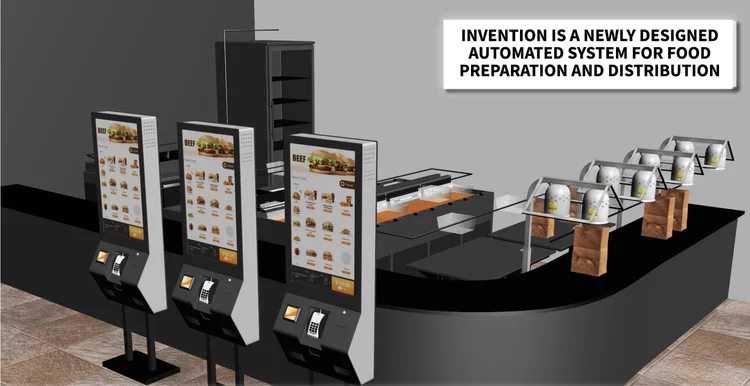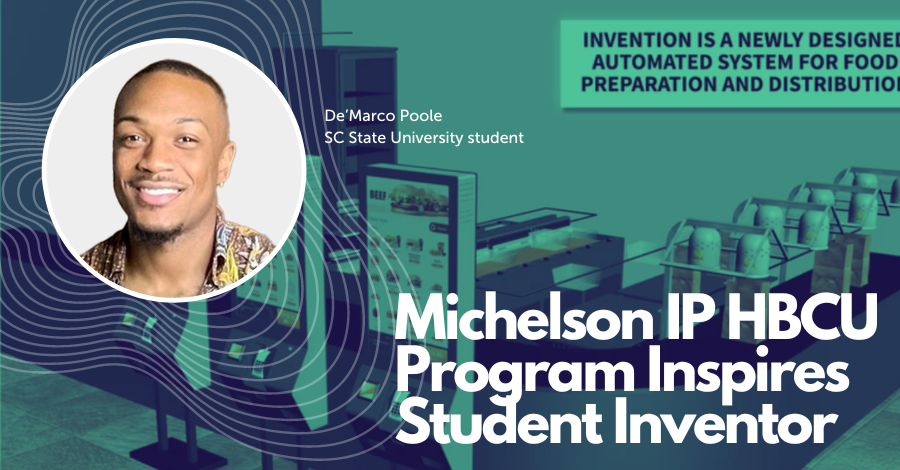South Carolina State University student De’Marco Poole used what he learned from the HBCU IP Futures Collaborative, a program by the Los Angeles-based Michelson Institute for Intellectual Property, to apply for a patent for his automated food preparation invention.
By Justin Chapman
His order was taking forever. Whatever happened to fast food? he thought. It’s just not fast anymore.
And that gave De’Marco Poole an idea, which he’s spent the past eight years developing: a fully automated food preparation and distribution system for Quick Service Restaurants (QSRs) such as Chick-fil-A, KFC, McDonald’s, and Burger King. The invention, called Vextor SF-2/F-2, would also work in other institutions that serve food and have the capability to utilize the product on a larger scale, such as amusement parks, hotels, stadiums, and resorts.
With support from the Los Angeles-based Michelson Institute for Intellectual Property’s HBCU IP Futures Collaborative, Poole filed a patent application for his autonomous food processor with the U.S. Patent and Trademark Office before he even graduated from South Carolina State University.

Poole’s automated food preparation invention created to increase speed and preparation of fast food orders.
The purpose behind his invention is to put the “fast” back in “fast food.”
“The Vextor SF2 and F2 reduce the amount of human intervention necessary to operate or facilitate the functions of a fast food restaurant, where there’s usually a person seasoning, flouring, frying, or tending to a grill,” Poole said. “This product essentially takes those individuals out of necessity and automates that portion of it.”
Vextor also automates the order-taking step. Taking orders and preparing food are the two parts of the process that can slow the experience down, he explained.
“When you go to a QSR and you go through the drive-thru or into the lobby, two things happen at both of these junctures: the ability for a QSR to serve its customer is bottlenecked by the efficiency of the human operator that’s facilitating the interaction between the customer, as well as the customer themselves,” Poole said. “Those two internal dynamics are the reason why fast food isn’t fast anymore.”
“This technology doesn’t necessarily exist elsewhere. That’s the uniqueness of what I’m working on.”
With Vextor, once a customer is within a certain radius of a QSR, they’ll be able to begin placing their order on their phone.
“You’ll be able to access that company’s menu and pay for exactly what you want, then your order goes directly to my machine, and it can already begin processing the food,” he said. “This technology doesn’t necessarily exist elsewhere. That’s the uniqueness of what I’m working on.”
This initial version of Vextor focuses on chicken preparation and features an ordering panel, loading station, seasoning station, flouring station, frying station, and a pick-up location. Poole has another concept that focuses on grilled food such as burgers or other beef-centric QSRs.
At South Carolina State, Poole majored in mechanical engineering and political science. He graduated in May and started working as a nuclear engineer for GE in April.
South Carolina State was one of seven HBCUs that participated in Michelson IP’s intellectual property curriculum program, a faculty-led community of practice aimed at evangelizing IP education to fellow campus educators, creators, innovators, and entrepreneurs. As part of the program, Michelson IP provided digital curricula, resources, videos, textbooks, and $25,000 grants to the seven HBCUs that joined the program: Bethune Cookman University, Morehouse College, Norfolk State University, Tuskegee University, Hampton, South Carolina State, and Xavier.
“What Vextor does is it reduces the amount of human intervention necessary to operate or facilitate the functions of a [fast food restaurant].”
Poole initially applied for his patent over a year ago. He and his patent attorney had to first assess whether or not a patent was something that should or even could be pursued. Then they had to determine the right type of patent. Finally, they had to put together the application, which totals more than 100 pages. Poole expects to hear from the USPTO about his patent in March 2023.
Throughout the process, Poole received feedback from Dr. Barbara Adams, the professor of accounting at South Carolina State participating in the HBCU IP Futures Collaborative, which also provided some funding.
“What I learned is that it’s best to keep a patent as vague as possible, because the more explicit you get, the less you get,” Poole said. “If you tell them exactly what’s going on, then your protection stops there. But if you leave some ambiguity behind it, you might be able to gain additional protections you didn’t even consider.”
Poole said he believes all students should be taught about IP education at an early age.
“At the very least, you’ll know if you’re infringing upon something that is protected, because ‘I don’t know’ is not usually an acceptable excuse that’ll get you out of much of anything,” he said. “If we’re able to make sure more people are informed about it, perhaps that learning curve shortens and is not as steep and then they’re aware of what their options are should they ever have an idea.”
He said resources like those provided by the HBCU IP Futures Collaborative are always helpful. The IP education came at a critical time when he was ready to pursue protection for his product.
Poole is already taking steps to prepare for the day when his patent is approved. He recently reached out directly to a Chick-fil-A franchise owner in Wilmington, North Carolina, to discuss his product. The franchise owner then put him in touch with his corporate representatives.
“I never imagined that I would be working on something that could revolutionize an entire industry.”
“What we’ll see moving forward is how these particular QSRs will need it, and obviously it might have to be retrofitted to fit their needs, whether it’ll fit their spacing,” he said. “Chick-fil-A might say, ‘We need a particular build out of this concept, and then we would modify it,’ and then obviously that would possibly be an entirely new patented idea or product since it’s tailored specifically for them.”
Vextor was born out of an economics project Poole did in his senior year of high school. He came home from football practice one day and his stepfather said, “I’m tired of seasoning and flouring chicken. It’s a messy process and someone needs to do something about it.” Poole’s assignment involved coming up with an idea for a product and determining how to make it, who would buy it, whether it would be built by machines or people, whether it would be domestic or foreign, and how to market it. His idea eventually became the invention for which he has applied for a patent.
“I never imagined that I would be working on something that could revolutionize an entire industry,” he said.
But Poole wants to go even further than that. Ultimately, he wants Vextor to become a company that “remedies a lot of the world’s challenges, whether that’s introducing potable water to third world countries, finding salt water conversions, or giving funds to universities to bring more knowledge about things like intellectual property and how to protect the things people work on.”
While this is only the beginning for De’Marco Poole on his patent journey, it’s encouraging to see underrepresented inventors in the IP Futures Collaborative program making strides towards securing and reaping the benefits of the U.S. patent system.
_________
 The Michelson Institute for Intellectual Property, an initiative of the Michelson 20MM Foundation, provides access to empowering IP education for budding inventors and entrepreneurs. Michelson 20MM was founded thanks to the generous support of renowned spinal surgeon Dr. Gary K. Michelson and Alya Michelson. To learn more, visit 20mm.org.
The Michelson Institute for Intellectual Property, an initiative of the Michelson 20MM Foundation, provides access to empowering IP education for budding inventors and entrepreneurs. Michelson 20MM was founded thanks to the generous support of renowned spinal surgeon Dr. Gary K. Michelson and Alya Michelson. To learn more, visit 20mm.org.
